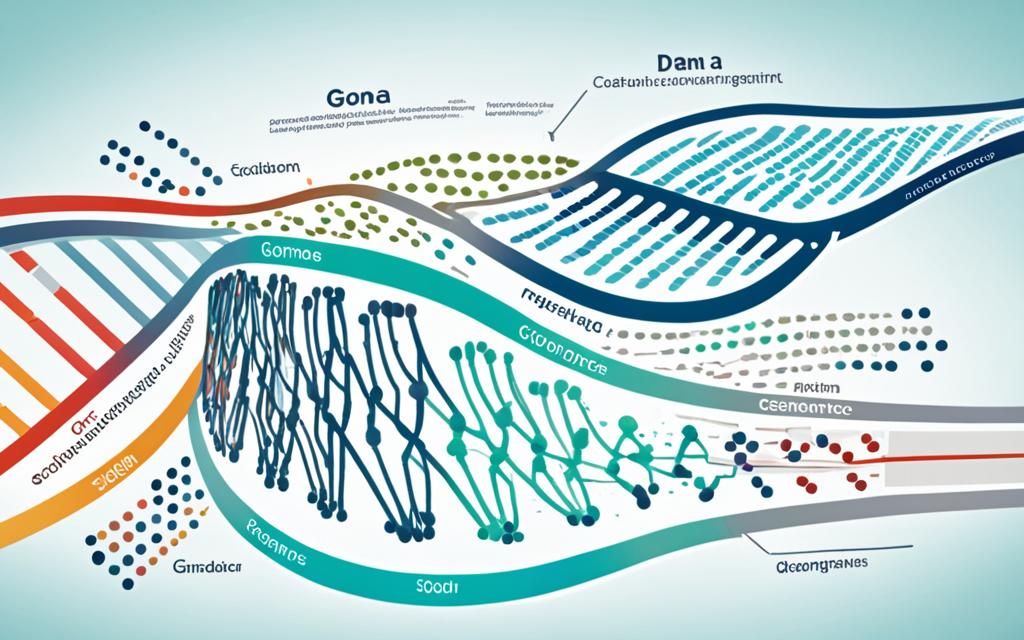Asian rice (Oryza sativa) has played a crucial role in sustaining human populations for centuries. However, with the global population continuing to grow, it is essential to explore new farming methods to meet the increasing demand for food. The study of PAN standards in rice genetics has been pivotal in understanding the genetic diversity of this staple crop and discovering innovative ways to enhance its productivity and resilience.
Advancements in genome sequencing technology have revolutionized the field, enabling researchers to map the subpopulation structure of Asian rice and identify key genetic variations. These variations, including inversions, have been found to impact gene expression, recombination, and linkage disequilibrium. By shedding light on the functional biology and performance of rice crops, these findings have paved the way for the development of new breeding strategies for improved varieties.
In this article, we will explore the importance of inversions in rice genomes, the advancements in genome sequencing technology that have facilitated PAN standards research, future directions in the field, and the implications for crop performance. Join us as we delve into the fascinating world of PAN standards evolution in Asian rice.
The Importance of Inversions in Rice Genomes
Inversions play a crucial role as a class of structural variation in rice genomes, significantly impacting gene expression, recombination rates, and linkage disequilibrium. Their influence extends to the functional biology and performance of rice crops, making them an essential area of study in crop improvement and breeding strategies.
Past research predominantly focused on small and mid-size inversions in rice. However, recent advancements using high-quality genome assemblies have revealed the prevalence and significance of large inversions (≥100 bp) across the pan-genome of Asian rice. These large inversions have been identified in both cultivated varieties and wild relatives, highlighting their evolutionary importance and potential for enhancing crop performance.
The discovery of these genetic variations in rice genomes not only deepens our understanding of rice biodiversity but also presents opportunities for targeted genetic manipulation to achieve desired agronomic traits. By harnessing the potential of inversions, breeders and geneticists can develop improved rice varieties that are better equipped to meet the challenges associated with increasing global food demand.
Further investigation into the structural and functional implications of inversions in rice genomes will continue to shed light on their contributions to crop adaptation, disease resistance, and overall productivity. This knowledge will assist in the development of innovative breeding strategies aimed at producing resilient, high-yielding rice varieties.
Note: The image above visually represents the concept of rice inversions, showcasing their significance in understanding genetic variations within rice genomes.
Advances in Genome Sequencing Technology
Recent advances in genome sequencing technology have greatly facilitated the study of PAN standards in rice. Researchers have utilized high-quality genome assemblies to build a pan-genome inversion index, which includes non-redundant inversions identified across multiple rice genomes. This index provides a comprehensive understanding of inversions (≥100 bp) in Asian rice and their evolutionary impacts. Additionally, the use of long-read sequencing and de novo assembly techniques has allowed for the inclusion of wild relatives and outgroup species in the analysis, expanding our knowledge of genetic diversity and its role in rice evolution.

Future Directions in PAN Standards Research
The study of PAN standards in rice is an ongoing and dynamic field of research. As technological advancements continue to improve genome sequencing methods, researchers will be able to generate even more comprehensive pan-genome inversion indices and explore the full extent of genetic diversity in Asian rice. Understanding the functional biology and performance of inversions will be critical for the development of new breeding strategies that can improve crop performance and meet the challenges of feeding a growing global population. Additionally, the integration of other omics data, such as transcriptomics and proteomics, will provide further insights into the molecular mechanisms underlying the effects of inversions on gene expression and crop traits.
Future Trends in PAN Standards Research
In the future, the study of PAN standards in rice is expected to follow several promising trends. One major trend is the utilization of advanced technologies like CRISPR/Cas9 gene editing, which allows for targeted modifications of specific DNA sequences. This will enable researchers to investigate the impact of specific inversions on crop performance and explore their potential for improving traits such as yield, disease resistance, and stress tolerance. By identifying and understanding the functional consequences of inversions, scientists can develop more precise breeding techniques that will result in the creation of high-performance rice varieties.
“The integration of other omics data, such as transcriptomics and proteomics, will provide further insights into the molecular mechanisms underlying the effects of inversions on gene expression and crop traits.”
Another future trend in PAN standards research is the inclusion of diverse rice varieties in the analysis. This will help in understanding the extent of genetic diversity within the Asian rice pan-genome and its implications for crop improvement. By studying the inversions present in cultivated rice varieties as well as their wild relatives, researchers can gain a comprehensive understanding of the genetic basis of desirable traits. This knowledge will contribute to the development of breeding strategies that harness the full potential of Asian rice genetic diversity.
Furthermore, the integration of omics data, such as transcriptomics and proteomics, will provide valuable insights into the molecular mechanisms underlying the effects of inversions on gene expression and crop performance. By analyzing gene expression patterns and protein profiles, researchers can identify the specific genes and pathways affected by inversions, leading to a deeper understanding of their functional consequences. This integrated approach will enable scientists to develop more targeted and efficient breeding strategies that optimize crop performance and address the challenges of climate change and food security.
Comparative Analysis of PAN Standards Research Trends
| Trend | Advantages | Implications |
|---|---|---|
| Utilization of advanced gene editing technologies | – Targeted modifications – Exploration of inversion effects – Improved crop traits |
– High-performance rice varieties – Increased yields – Disease resistance |
| Inclusion of diverse rice varieties | – Comprehensive genetic diversity analysis – Understanding of genetic basis of traits – Harnessing full potential of rice genetic diversity |
– Improved breeding strategies – Adaptation to changing environments – Enhanced crop resilience |
| Integration of omics data | – Deeper understanding of molecular mechanisms – Identification of affected genes and pathways |
– Targeted and efficient breeding strategies – Optimized crop performance – Addressing climate change and food security |
Note: This table provides a comparative analysis of future trends in PAN standards research, highlighting their advantages and implications for crop improvement and global food security.
Conclusion
The study of PAN standards in rice has provided valuable insights into the genetic diversity of Asian rice, particularly through the examination of inversions. These structural variations have been observed to have significant impacts on gene expression, recombination rates, and linkage disequilibrium, highlighting their importance in the functional biology and performance of rice crops.
Continued advancements in genome sequencing technology offer exciting prospects for further research in PAN standards. With improved methods, researchers can delve deeper into the study of inversions across diverse rice genomes, allowing for a more comprehensive understanding of genetic diversity. Additionally, the integration of other omics data, such as transcriptomics and proteomics, will provide a multidimensional view of the molecular mechanisms underlying the effects of inversions on gene expression and crop traits.
The knowledge gained from PAN standards research holds incredible potential for the development of new breeding strategies and improved rice varieties. By harnessing the genetic diversity uncovered through the study of inversions, researchers can work towards meeting the challenges of feeding a growing global population with more productive, resilient, and sustainable rice crops.
FAQ
What are PAN standards in rice?
PAN standards in rice refer to the study of genetic diversity and variations within the Asian rice (Oryza sativa) crop. It involves analyzing the subpopulation structure, genome sequencing, and mapping of key genetic variations, including inversions, to understand their impact on gene expression, recombination, and crop performance.
How do inversions affect rice genomes?
Inversions are structural variations in rice genomes that have been found to affect gene expression, recombination rates, and linkage disequilibrium. They play a significant role in the functional biology and performance of rice crops and have the potential for improving crop varieties.
What have recent studies revealed about large inversions in rice genomes?
Recent research using high-quality genome assemblies has revealed the prevalence and scale of large inversions (≥100 bp) across the pan-genome of Asian rice. These large inversions have been found in both cultivated varieties and wild relatives, indicating their evolutionary importance and potential for crop improvement.
How is genome sequencing technology used in PAN standards research?
Genome sequencing technology has greatly facilitated the study of PAN standards in rice. High-quality genome assemblies are used to build a pan-genome inversion index, which provides a comprehensive understanding of inversions (≥100 bp) in Asian rice and their evolutionary impacts. Long-read sequencing and de novo assembly techniques enable the inclusion of wild relatives and outgroup species, expanding our knowledge of genetic diversity and its role in rice evolution.
What are future directions in PAN standards research?
As genome sequencing technology continues to advance, future research in PAN standards will focus on expanding our understanding of inversions across diverse rice genomes and incorporating additional omics data. This includes the integration of transcriptomics and proteomics data to gain further insights into the molecular mechanisms underlying the effects of inversions on gene expression and crop traits.
How will PAN standards in rice contribute to improved crop performance?
The study of PAN standards in rice provides valuable insights into the genetic diversity and functional biology of the crop. This knowledge will contribute to the development of new breeding strategies and improved rice varieties that can meet the demands of a growing global population by enhancing crop performance and productivity.



















